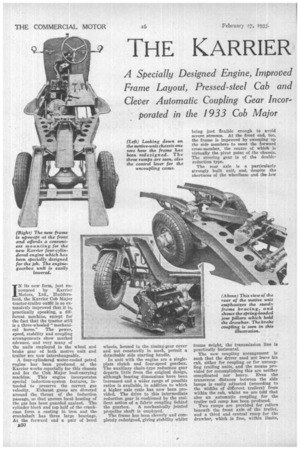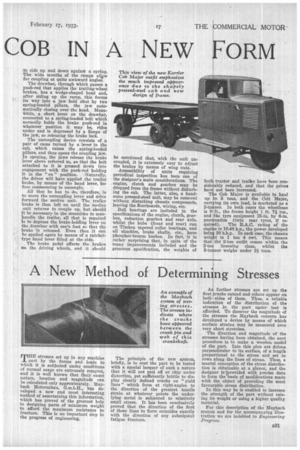THE KARRIER
Page 44

Page 45

If you've noticed an error in this article please click here to report it so we can fix it.
COB IN A NEW IN its new form, just anflounced by Karrier Motors, Ltd., Ruddersheld, the Earlier Cob Major tractor-trailer outfit is so extensively improved that it is, practically speaking, a different machine, except for the fact that the tractor still is a three-wheeled " mechanical horse." The power, speed, stability and coupling
arrangements show marked advance, and very many of the units employed in the wheel and brake gear of both motive unit and trailer are now interchangeable.
A four-cylindered water-cooled petrol engine has been produced at the Karrier works especially for this chassis and for the Colt Major load-carrying machine. This engine incorporates special induction-system features, intended to preserve the correct gas velocity. Exhaust gases are directed around the throat of the induction passage, so that uneven local heating of the gas has been guarded against. The cylinder block and top half of the crankcase form a casting in iron and the crankshaft has three large bearings. At the forward end a pair of bevel
.1330 wheels, housed in thetiming-gear cover and not constantly in mesh, permit a detachable side starting handle.
In unit with the engine are a singleplate clutch and four-speed gearbox. The auxiliary chain-type reduction gear departs little from the original design, although bearing dimensions have been increased and a wider range of possible ratios is available, in addition to which a higher axle ratio has now been provided. The drive to this intermediate reduction gear is cushioned by the resilient action of a fabric coupling behind the gearbox. A mechanically jointed propeller shaft is employed.
The frame has been cleverly and completely redesigned, giving stability whilst being just flexible enough to avoid severe stresses. At the front end, too, the frame is improved by sweeping up the side members to meet the forward cross-member, the centre of which is virtually the pivot point of the chassis. The steering gear is of the doublereduction type.
The rear axle is a particularly strongly built unit, and, despite the shortness of the wheelbase and the low
trame height, the transmission line is practically horizontal.
The new coupling arrangement is such that the driver need not leave his cab, either for coupling or for uncoupling trailing units, and the means provided for accomplishing this are neither complicated nor heavy. Even the transverse distance between the side lamps is easily adjusted (according to the widths of different trailers) front within the cab, whilst we are told that also an automatic coupling for the trailer tail ramp has been produced.
Two ramps are • provided for rollers beneath the front axle of the trailer, and a third and central ramp for the drawbar, which is free, within limits, to ride up and down against a spring. The wide mouths of the ramps all.pw for coupling at quite awkward anglee: The drawbar, through which passes a push-rod that applies the trailing-wheel brakes, has a wedge-shaped head and, after riding up the ramp, this forces its way into a jaw held shut by two spring-loaded pillars, the jaw automatieally closing over the head. MeanWhile, a short lever on the drawbar, connected to a spring-loaded bolt which normally holds the brake push-rod in whatever position it may be, rides under and is depressed by a flange of the jaw, so releasing the brake lock.
The uncoupling device consists of a pair of cams turned by a lever in the cab, which raises the spring-loaded pillars, and thus opens the coupling jaw. In opening, the jaws release the brake lever above referred to, so that the bolt attached to it is pressed down into engagement with the push-rod holding it in the " on " position. Naturally, the driver will have applied the trailer brake, by means of the hand lever, before commencing to uncouple.
All that he has to do, therefore, is to move the uncoupling lever and drive forward the motive unit. The trailer brake is then left on until the motive unit returns to couple up, but should it be necessary in the meantime to manhandle the trailer, all that is required Is to depress the brake-holding lever on the drawbar with one's foot so that the brake is released. Even then it can be applied again by means of a ratchettype hand lever fitted at the side.
The brake pedal affects the brakes on the driving wheels, and it should be mentioned that, with the unit uncoupled, it is extremely easy to adjust the brakes by means of wing nuts. Accessibility of units requiring periodical inspection has been one of the designer's main considerations. The engine, clutch and gearbox may he dropped from the frame without disturbing the cab. The latter, also, a handsome pressed-steel unit, may be removed without disturbing chassis components, leaving the floorboards, wiring, etc.
Ball bearings are included in the specifications of the engine, clutch, gearbox, reduction gearbox and rear axle, whilst the hubs (front and roar) run on Timken tapered roller bearings, and all shackles, brake shafts, etc., have phosphor-bronze bushes. In fact, it is rather surprising that, in spite of the many improvements included and the generous specification, the weights of both tractor and trailer have been considerably reduced, and that the prices have not been increased.
The Cob Major is available to haul up to 5 tons, and the Colt Major, carrying its own load, is marketed as a 2-tonner. In both cases the wheelbase is 9 ft., the frame height 1 ft. 7/ ins., and the tyre equipment 25-in. by 6-in. pneumatics (twin rear tyres, if re quired). The R.A.C. rating of the engine is 10.48 h.p., the power developed being 30 b.h.p. In each case, the chassis weight is 1. ton 4 cwt. This means that the 2-ton outfit comes within the 2-ton licensing class, whilst the 5-tanner weighs under 2i tons.




























































































